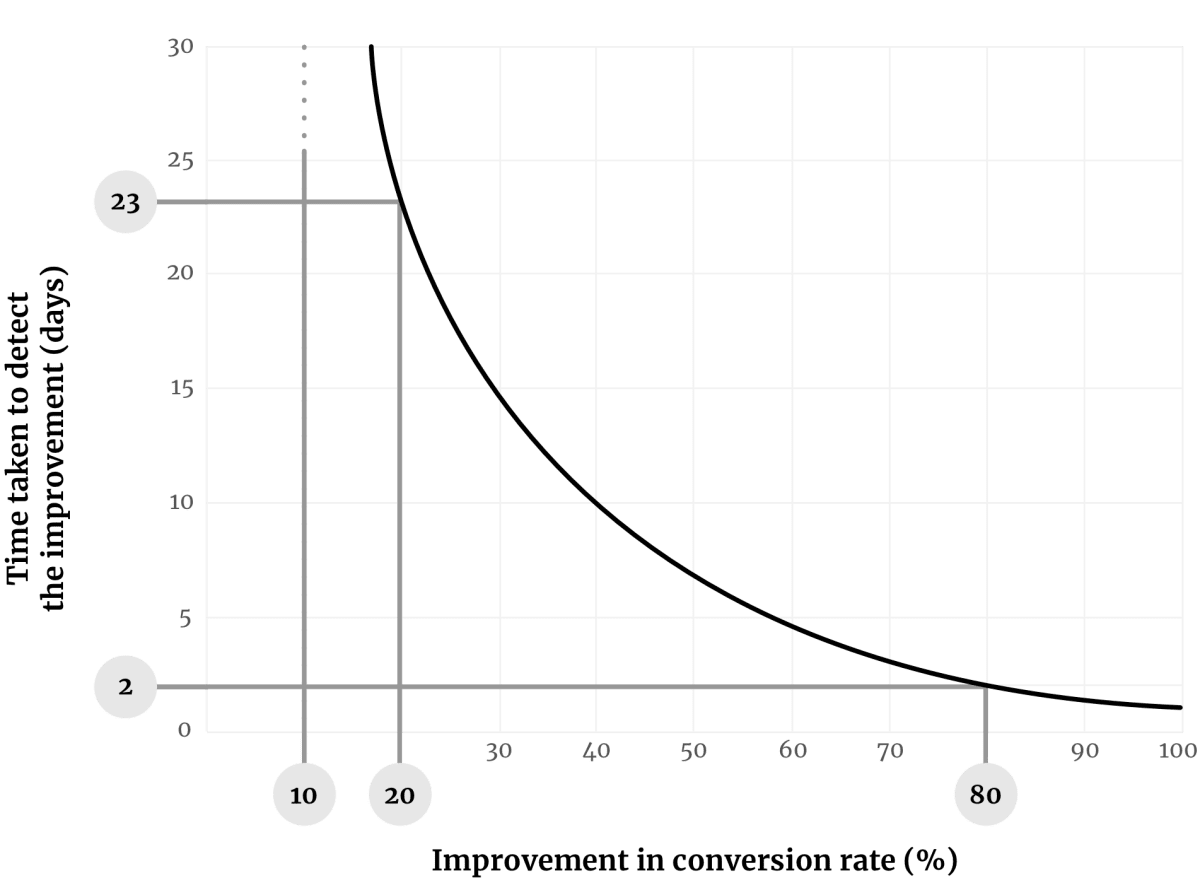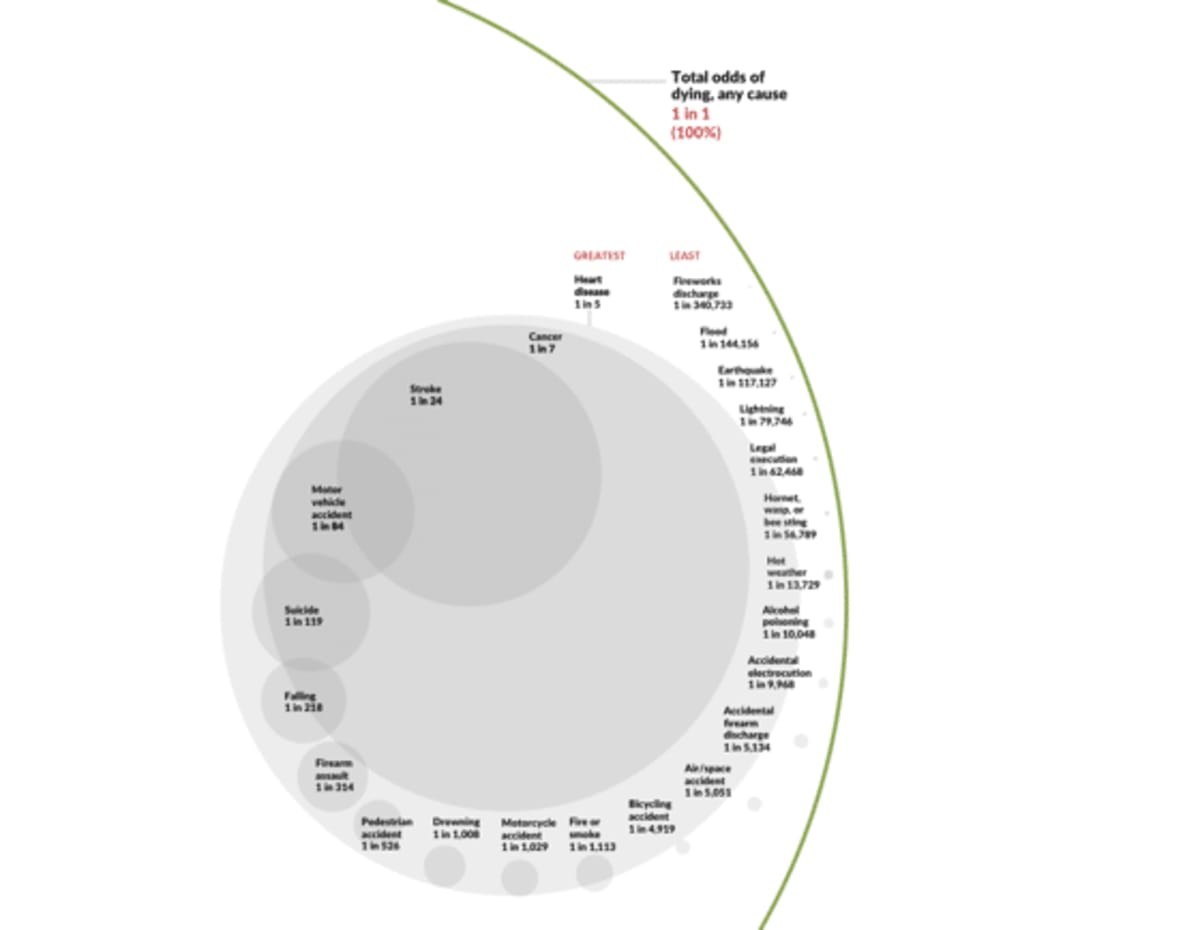Meek tweaking (and blindly applying best practices)
(By the way, to get articles like this free in your inbox, subscribe to our newsletter.)
(This is one of a series of articles, the first of which is here.)
The second mistake people make when optimizing their websites is what we call meek tweaking. They set up A/B-testing software, then they make daft changes. They change button colors and shuffle items around the page, just because they read that it worked for someone else. The following equation from the world of computer science explains why that approach is bad:

“GI–>GO” stands for “Garbage In” leads to “Garbage Out.” In other words, if you put garbage into your A/B-testing software, you will get garbage out of it. (Albeit optimized garbage.)
The following graph explains why that approach is more harmful than it sounds.

The horizontal axis shows the improvement you are looking to detect. The vertical axis shows the time it will take to detect that improvement.
The line shows how long it will take for an A/B test to reach completion. It’s for a page that gets 300 views/day (that’s about 9,000 views/month). The shape of the curve would be similar (just higher or lower) for other traffic volumes.
Imagine that you have just designed a new version of such a page, and your new version has an 80% higher conversion rate than the existing version. As you can see in the graph, the time taken to detect that improvement would be just two days.
Whereas if your new version was only 20% better than the existing page, the split-test would take 23 days to reach completion.
In other words, to detect an improvement that’s a quarter as large (20% compared with 80%), then your A/B test would take over ten times as long (23 days compared with 2 days).
If you were looking to detect a 10% improvement, then the split-test would take several months to conclude.
The moral of the story is that small improvements take ages to detect, disproportionately and counterintuitively so.
So you should aim for bold, targeted changes, because
- Each change gets you more profit (an 80% improvement gives four times the benefit of a 20% improvement, obviously).
- It’s more fun and interesting.
- It’s much quicker.
Whereas if you’re doing what we call meek tweaking—making small, arbitrary changes, then
- You tend to get no wins. Your split-tests never reach conclusion.
- This becomes disheartening, and you lose motivation.
- You lose the buy-in from all the other people in your company whom you persuaded that A/B testing was going to be a good idea.
How to avoid meek tweaking (and ensure that your tests have a high likelihood of winning)
Most marketers do things to their websites that they’d never do to their bodies.
The following graphic went viral a few years ago:

The diagram shows the most common causes of death in people. You can see the data here. The most upsetting one is the “total odds of dying of any cause” which, of course, is 100%.
On seeing this diagram, only a fool would rush to a pharmacy and start taking medication against every possible ailment, wolfing down pills for diseases they don’t have. Such behavior would cause more harm than good. Instead, sensibly, when someone is ill, they go to a doctor who first diagnoses what’s wrong and only then prescribes the most relevant remedy.
That may sound obvious for health, but it’s not what people do with their websites. Most web marketers run straight to the “marketing pharmacy” and cram their webpages with every possible remedy. Then they wonder why they have a website that’s cluttered, full of distraction and converts no better—or even worse—than the previous version. Their visitors had specific objections, but instead of overcoming those objections, the marketers filled their pages with irrelevant distractions.
Your visitors’ attention is limited. You must treat it preciously.
O/CO (a way to stop yourself from meek tweaking)
Our approach to conversion is much more effective than the one described above. We call it O/CO, which stands for “Objection/Counter-Objection.” This mental model is the web-marketing equivalent of the doctor diagnosing what is wrong, then coming up with an appropriate remedy.
How can you apply O/CO? First, you need to identify your visitors’ objections. There are many tools for finding out why your visitors don’t convert. In the article “14 tools that reveal why potential customers abandon your website,” we reveal some of the tools we use to find out why your visitors aren’t converting. By applying those tools to your website, you can hear your visitors’ objections in detail.
However, in the following section, we will describe an additional group of techniques that we find to be particularly fruitful.
Read the next article in this series
This article is one of a series that began here. The next in the series is here.
How much did you like this article?
What’s your goal today?
1. Hire us to grow your company
We’ve generated hundreds of millions for our clients, using our unique CRE Methodology™. To discover how we can help grow your business:
- Read our case studies, client success stories, and video testimonials.
- Learn about us, and our unique values, beliefs and quirks.
- Visit our “Services” page to see the process by which we assess whether we’re a good fit for each other.
- Schedule your FREE website strategy session with one of our renowned experts.
Schedule your FREE strategy session
2. Learn how to do conversion
Download a free copy of our Amazon #1 best-selling book, Making Websites Win, recommended by Google, Facebook, Microsoft, Moz, Econsultancy, and many more industry leaders. You’ll also be subscribed to our email newsletter and notified whenever we publish new articles or have something interesting to share.
Browse hundreds of articles, containing an amazing number of useful tools and techniques. Many readers tell us they have doubled their sales by following the advice in these articles.
Download a free copy of our best-selling book
3. Join our team
If you want to join our team—or discover why our team members love working with us—then see our “Careers” page.
4. Contact us
We help businesses worldwide, so get in touch!
© 2024 Conversion Rate Experts Limited. All rights reserved.










